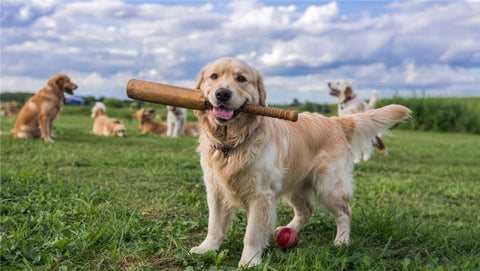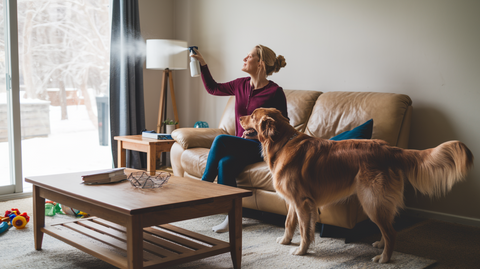Cool and Comfy: The Ultimate Guide to Summer Care for Your Dog
Signs Your Dog is Struggling in the Summer Heat and How to Help
Summer is approaching, and while we keep ourselves hydrated with water, juice, and other refreshing drinks, we often forget about our beloved dogs. Summer care for dogs is essential, as they, too, suffer from the heat, facing challenges like dehydration, tick infestations, rough coats, and hygiene concerns. The rising temperatures and humidity can leave them exhausted, itchy, or even unwell.
As a responsible pet parent, it’s important to take extra care to keep your dog safe and comfortable during the hot months. Here are some common problems your dog may face in summer and simple ways to help them stay cool and comfortable at home.
1. Dehydration and Overheating
Dogs do not sweat like humans. They rely on panting to cool down, but extreme heat can cause dehydration or even heatstroke, which can be life-threatening.
Signs of Dehydration in Dogs
-
Dry nose and gums: A dog’s nose and gums should be moist. Dryness indicates dehydration and can lead to infections if not addressed.
-
Excessive panting: Panting helps dogs cool down, but persistent heavy panting can signal overheating.
-
Lethargy and weakness: Dehydrated dogs may seem sluggish, disinterested in play, and even collapse in extreme cases.
-
Loss of appetite: A dehydrated dog may eat less or refuse food, worsening their condition.
-
Sunken eyes: Dehydration reduces body moisture, making the eyes appear dull or sunken.
-
Thick, sticky saliva: Normal saliva should be watery. Thick saliva can indicate dehydration, making swallowing difficult.
How to Keep Your Dog Hydrated

-
Ensure fresh, clean water is available at all times and refill it regularly.
-
Add ice cubes to their water bowl for a cooling effect.
-
Offer water-rich foods like cucumber or watermelon (in moderation).
-
Avoid taking your dog out during peak heat hours; early mornings and evenings are best.
-
Provide a shaded area if your dog spends time outdoors.
-
Use cooling mats or damp towels to regulate body temperature.
-
Never leave your dog in a parked car- temperatures inside can rise dangerously fast.
2. Ticks and Fleas: The Summer Trouble

Warm weather is ideal for ticks and fleas, which can cause irritation, allergies, and diseases like Lyme disease and tick fever.
Signs of Tick or Flea Infestation
-
Constant scratching or biting: Dogs scratch or bite themselves excessively to relieve itching caused by parasites.
-
Red, inflamed skin: Ticks and fleas can cause allergic reactions, leading to swollen, irritated skin.
-
Hair loss or bald patches: Scratching and biting can result in bald spots, often around the ears, belly, and tail.
-
Tiny black or brown spots moving in their fur: Fleas appear as tiny, fast-moving dots, often found around the neck, belly, or tail.
-
Small scabs or wounds: Flea or tick irritation can lead to wounds that may become infected if left untreated.
How to Protect Your Dog from Ticks and Fleas
-
Check your dog’s fur daily, especially around the ears, neck, and paws.
-
Bathe them with a tick and flea shampoo to wash away fleas and ticks.
-
Keep your dog’s bedding, toys, and surroundings clean.
-
Vacuum carpets and furniture regularly to remove flea eggs and ticks.
-
Use tick collars or natural repellents like neem oil or eucalyptus for additional protection.
3. Dry and Rough Coat
The sun, frequent baths, and swimming can strip your dog’s coat of its natural oils, leading to dryness, rough texture, and tangles.
Signs of a Dry and Damaged Coat
-
Brittle or rough fur: A healthy coat should be soft and smooth. Sun exposure, poor nutrition, or harsh shampoos can make the fur brittle.
-
Increased shedding: While some shedding is normal, excessive hair loss can signal an unhealthy coat or skin issues. Using a hair fall control shampoo for dogs can help strengthen the coat, reduce shedding, and maintain healthy skin.
-
Tangled or matted hair: Matted fur traps dirt and moisture, increasing the risk of infections. Regular grooming with a dog brush helps prevent tangles, removes dirt, and keeps the coat healthy.
-
Dull appearance: A coat lacking essential oils looks lifeless and unhealthy.
How to Keep Your Dog’s Coat Soft and Healthy
-
Use a dog conditioner after shampooing to restore moisture and shine.
-
Use dog hair serum and a dog brush to regularly groom your pet, removing dirt, preventing matting, and keeping their coat tangle-free and healthy.
-
Limit bathing, as excessive washing can strip natural oils and dry out the skin.
-
Include omega-rich foods like fish and flaxseed in their diet for better coat health.
-
Apply coconut oil or aloe vera to naturally hydrate the skin and fur.
4. Odor and Hygiene Issues
Hot and humid weather can lead to unpleasant odors due to sweat buildup in the paw pads, outdoor dirt, and bacteria.
Common Summer Hygiene Problems
-
Dirty paws from outdoor walks: Dogs pick up dirt, mud, and germs on their paws, which can cause infections or irritation.
-
Sweat and odor buildup in fur: Unlike humans, dogs sweat through their paw pads and certain areas, causing body odor.
-
Bacteria accumulation in bedding and accessories: Unwashed bedding and collars can breed bacteria, leading to bad smells and infections.
How to Keep Your Dog Fresh and Clean
-
Wipe their paws with a pet-safe sanitizer after outdoor walks.
-
Wash their bedding, toys, and collars frequently to prevent bacteria buildup.
-
Bathe them regularly with a mild dog shampoo to remove sweat and dirt.
-
Brush their teeth to maintain oral hygiene and prevent bad breath.
Extra Tips for Keeping Your Dog Comfortable in Summer
-
Invest in a cooling vest – These helps regulate your dog’s body temperature.
-
Set up a kiddie pool – Letting your dog splash in cool water can be refreshing.
-
Keep them indoors during heatwaves – Too much sun exposure can be dangerous.
-
Use dog-friendly sunscreen – Light-colored or short-haired dogs are more prone to sunburn.
-
Trim their fur, but don’t shave it off – Their coat protects them from both heat and sunburn.
Summer can be tough on dogs, but with proper hydration, tick prevention, coat conditioning, and hygiene, they can stay comfortable and healthy. Ensuring they have access to fresh water, using tick repellents, applying a good conditioner, and keeping their paws clean will go a long way in protecting them from heat-related issues.



